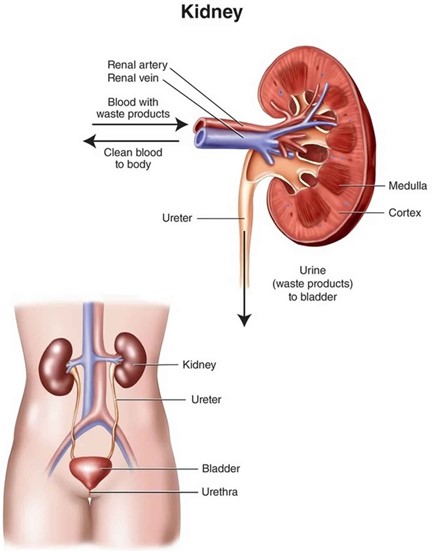The nurse is planning discharge instructions for a client with type 2 diabetes who will be starting exenatide.
Which information should be included in the discharge instructions?
Exenatide acts in the same way as insulin in lowering blood glucose.
Inject exenatide within 30 minutes before or after a meal.
There are no precautions about taking exenatide with other medications.
Notify your healthcare provider if you start having abdominal pain.
The Correct Answer is D
The correct answer is choice d. Notify your healthcare provider if you start having abdominal pain.
Choice A rationale:
Exenatide does not act in the same way as insulin. It is a GLP-1 receptor agonist that enhances glucose-dependent insulin secretion, suppresses glucagon secretion, and slows gastric emptying.
Choice B rationale:
Exenatide should be injected within 60 minutes before the morning and evening meals, not within 30 minutes before or after a meal.
Choice C rationale:
There are precautions about taking exenatide with other medications. It can affect the absorption of oral medications, so timing and interactions need to be considered.
Choice D rationale:
Abdominal pain can be a sign of pancreatitis, a serious side effect of exenatide. It is important to notify the healthcare provider if this symptom occurs.
Nursing Test Bank
Naxlex Comprehensive Predictor Exams
Related Questions
Correct Answer is B
Explanation
Choice A rationale:
Reporting the 24-hour intake at the current infusion rate is not the most important finding to report to the healthcare provider in this case. It is essential to monitor intake and output, but a single report of the 24-hour intake is not as critical as other findings.
Choice B rationale:
Reporting a serum potassium level of 3.1 mEq/L (3.1 mmol/L) is the most important finding to report to the healthcare provider. The patient's potassium level is below the normal range, indicating hypokalemia. Hypokalemia can have serious cardiac and neuromuscular effects, including arrhythmias and muscle weakness. Prompt intervention, such as potassium supplementation or adjustment of IV fluids, is necessary to address this potentially life-threatening condition.
Choice C rationale:
Reporting a gastric output of 900 mL in the last 24 hours is significant and should be reported to the healthcare provider, but it is not as urgent as the low potassium level. Gastric output should be monitored to assess for signs of improvement or worsening, but hypokalemia takes precedence due to its immediate health risks.
Choice D rationale:
Reporting an increased blood urea nitrogen (BUN) is important for the overall assessment of the patient's renal function but is not the most critical finding in this scenario. The low potassium level is a more immediate concern and requires immediate attention.
Correct Answer is D
Explanation
This is the correct answer because BUN and creatinine are the most important laboratory values to monitor for nephrotoxicity, which is the damage or injury to the kidneys caused by certain drugs or chemicals.
Nephrotoxicity can impair the kidneys' ability to filter waste products from the blood, resulting in elevated levels of BUN and creatinine. The normal range for BUN is 7 to 20 mg/dL, and for creatinine is 0.6 to 1.2 mg/dL. The practical nurse (PN) should review these values before administering an antibiotic that can cause nephrotoxicity, such as aminoglycosides, cephalosporins, vancomycin, or sulfonamides. The PN should also monitor the client for signs and symptoms of nephrotoxicity, such as decreased urine output, edema, hypertension, fatigue, nausea, and confusion.
a) Serum calcium
This is not the correct answer because serum calcium is not directly related to nephrotoxicity. Serum calcium is the amount of calcium in the blood, which is important for bone health, muscle contraction, nerve function, and blood clotting. The normal range for serum calcium is 8.5 to 10.2 mg/dL. Serum calcium may be affected by kidney disease, but it is not a reliable indicator of nephrotoxicity.
b) Hemoglobin and hematocrit
This is not the correct answer because hemoglobin and hematocrit are not directly related to nephrotoxicity. Hemoglobin is the protein in red blood cells that carries oxygen, and hematocrit is the percentage of red blood cells in the blood. The normal range for hemoglobin is 13.5 to 17.5 g/dL for men and 12 to 15.5 g/dL for women, and for hematocrit is 38.8 to 50% for men and 34.9 to 44.5% for women.
Hemoglobin and hematocrit may be affected by kidney disease, but they are not reliable indicators of
nephrotoxicity.
c) White blood cell count (WBC)
This is not the correct answer because WBC is not directly related to nephrotoxicity. WBC is the number of white blood cells in the blood, which are part of the immune system and fight infections. The normal range for WBC is 4,500 to 10,000 cells per microliter of blood. WBC may be elevated in response to an infection or inflammation, but it is not a reliable indicator of nephrotoxicity.

Whether you are a student looking to ace your exams or a practicing nurse seeking to enhance your expertise , our nursing education contents will empower you with the confidence and competence to make a difference in the lives of patients and become a respected leader in the healthcare field.
Visit Naxlex, invest in your future and unlock endless possibilities with our unparalleled nursing education contents today
Report Wrong Answer on the Current Question
Do you disagree with the answer? If yes, what is your expected answer? Explain.
Kindly be descriptive with the issue you are facing.
